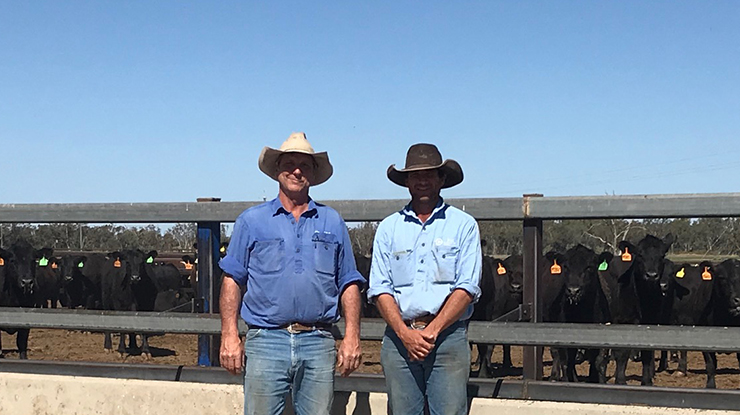 RMI Livestock Manager, Brett Meyer and Feedlot Supervisor, Jerry Daley
RMI Livestock Manager, Brett Meyer and Feedlot Supervisor, Jerry Daley
Focus on eating quality key to success for Carrington Cotton
A commitment to constantly improving beef eating quality has led to the Goondiwindi-based agricultural company, RMI Pty Limited (Carrington Cotton Group), being awarded the 2019 MSA Excellence in Eating Quality Progress Award for Queensland.
This means RMI showed the greatest improvement in their MSA compliance and MSA Index scores since the last MSA Awards series in 2017.
RMI is a family owned agricultural farming group which operates a diverse range of activities including a cattle enterprise of breeding, backgrounding, and lot feeding cattle, in conjunction with irrigated cotton, ginning, warehousing (cotton and cottonseed) and logistics, broadacre grains and pulses and a Quarter Horse Stud.
Within the company’s holdings the cattle grazing enterprise spans over 12,700 hectares across four main Queensland properties near Goondiwindi – ‘Oonavale’, ‘Kildonan’, ‘Murragoran’and ‘Lagoona’, combined with a dryland cropping area of around 2,736 hectares, to support its feedlot activities.
RMI Livestock Manager, Brett Meyer, said the livestock program consists of a breeding herd of 400 Angus females, as well as a background program of 2400 steers and heifers, comprising 30% Angus and 70% British-Euro cross breeds, which are sourced locally, as much as possible.
“We have capacity for 1000 head to be finished on the feedlot at ‘Murragoron’,” Brett said.
“We produce our own cottonseed, grain, hay, straw and silage for the feedlot and our backgrounding cattle are grazed on a program of forage oats during the winter spring months and forage sorghum throughout the summer.
“Our heavy, wetter country lends itself to pastures including bambatsi, whilst our lighter country is predominantly buffel.
“We started lot feeding in 2017 and have settled in to the 100-day grainfed market.
“In the feedlot, our growth target is 2.2kg per head, per day for heifers and 2.5kg per head, per day for steers, and we turn off around 5000 head annually, with the majority sent for processing for MSA.”
Brett said targeting MSA specifications had been an advantage to RMI on both a productivity and profitability level.
“The MSA price grid is the highest target price on the kill grid. Adhering to MSA compliance specifications means we are producing better quality beef for our target market and producing more cents per kilogram of beef,” Brett said.
“Focusing on meat eating quality is the way of the future for the beef industry and we are placing great importance on attributes that enhance meat quality, as well as structural soundness.
“When we’re buying bulls, we select for a range of Estimated Breeding Values (EBVs), including birthweight, 200- 400- and 600-day growth rates, eye muscle area, rump fat and fertility.”
Low-stress livestock handling and training staff in best management practices to ensure pH levels are kept low in the cattle to prevent dark cutting is another key to consistently achieving MSA compliance for RMI.
“We operate our feedlot with easy flow, simple pathways and pre-mapping plans for how we move cattle so we don’t cause confusion and stress,” Brett said.
“We try to minimise the amount of noise surrounding the cattle, and always choose the coolest time of the day to transport them.”
Brett said RMI is starting to use the myMSA platform to check carcase feedback as a tool in their goal to improve eating quality.
“The value of MSA compliance is similar to when the price grid system was first introduced. It has obviously improved the quality of the cattle Australia produces and our access to export markets,” Brett said.
“We need to keep improving the beef industry through these grading systems so we can continue to target consumers in our global markets.”



